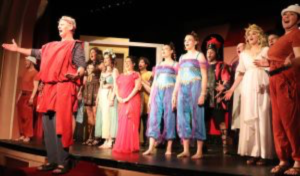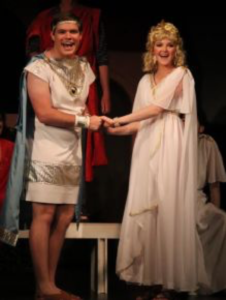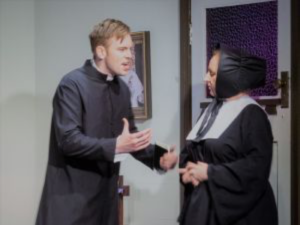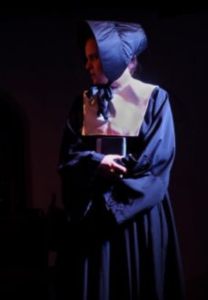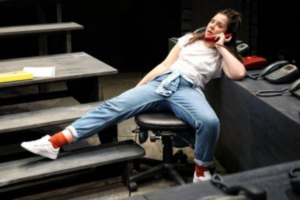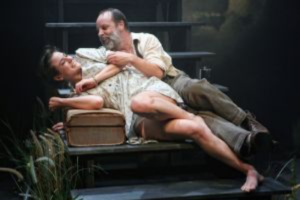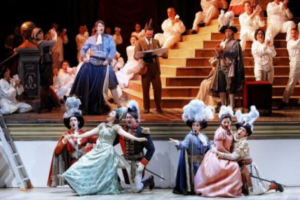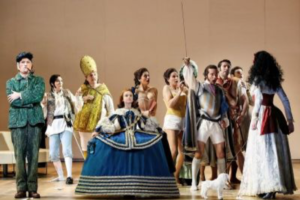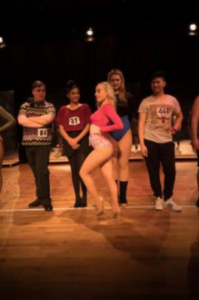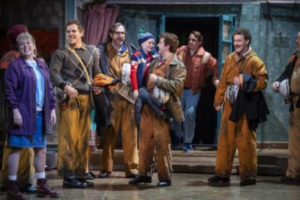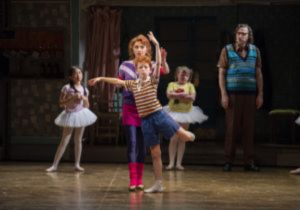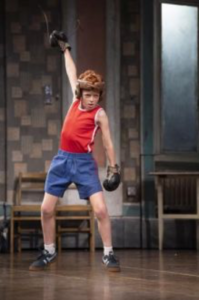By Jessica Swale. Castle Hill Players. Pavilion Theatre, Castle Hill Showgrounds. Nov 15 – Dec 7, 2019.
Reviewed : November 11, 2019

Theatre stages see many transformations, but surely there are few more different than that which has occurred at the Pavilion Theatre over the past few weeks. From Anne Frank’s crowded, dimly lit garret in war-time Amsterdam, it is transformed to 17th century England and the reign of the “Merry Monarch”, King Charles II.
It’s a time of change. Oliver Cromwell is dead, and with him the austerity of his governance. Charles has returned from exile in France, has reopened the taverns and theatres and, in the royal circles, extravagance and debauchery rule.

Designer Maureen Cartledge has set the royal throne between marble pillars surrounded by shimmering red velvet curtains. A series of steps leads down to the wide stage where players rehearse under the guidance of Thomas Killigrew, and John Dryden desperately pens the missing scenes of his next play. Ribbon sellers ply their wares and stage-hand Nancy organises costumes and wigs.
Anthea Brown’s costumes are fashioned in rich brocades, lace cuffs, gold braid and long curling wigs … and that’s just the men! Skirts swish, fans flutter and elegant hats bob.
From the stalls in the theatre, prostitute turned orange seller Nell Gwynn cheekily heckles stammering Prologue Ned Spiggett, drawing the attention of the King’s Company’s leading actor, Charles Hart.
So begins her story. Under the tutelage of Hart, Nell becomes the first female actor in the company – and attracts the roving eye of the lascivious King, who sets her up as his latest mistress. It’s a tale told in words and song, with minstrels strumming and piping, and a cast of over twenty performers proving that they “can dance and sing”.
Tiffany Hoy leads the merriment as Nell, taking her character boldly from cheeky strumpet to popular thespian to loving mistress to devastated ‘widow’. Hoy finds the different dimensions of the character – sassily disrespectful, openly ambitious, unsophisticatedly lovestruck and wickedly satirical. It is not an easy role and Hoy carries it well.
Dan Ferris plays actor Charles Hart, confident, much revered and intriguingly taken in by Nell’s impudent confidence and charm. Ferris takes Hart from actor to tutor to rejected lover with seeming ease.
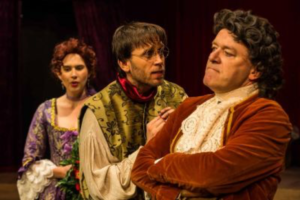
As does Richard Littlehales as Edward Kynaston, the actor displaced by Nell as the company’s leading ‘lady’! Littlehales pouts and poses, his fake breasts jiggling as he sulkily bemoans his loss of stature in the company. Dan Byron plays the nervous Ned Spiggett, Marilyn Parsons the busy dresser Nancy, and Kimberlea Smith is Nell’s sister and confidante, Rose.
Murray Fane is Thomas Killigrew, director of the King’s Company and Jason Spindlow plays the near-sighted, idea-blocked playwright, John Dryden.
The folk at Whitehall Palace are far more sophisticated and worldly. Paul Sztelma reigns benevolently as King Charles – and wears his brocade and lace with stylish ease. Sztelma moves elegantly in true ‘Restoration-mode’, stepping lightly and posing gracefully – as does Stephen Snars as his prudent and pretentious equerry, Lord Arlington.
Michelle Masefield delights with a rant in Portuguese as Queen Catherine, and Madeleine Dart and Samantha Camilleri are fashionably condescending as the King’s other mistresses, Lady Castlemaine and Louise de Keroualle. Both wear their elaborate costumes with as much style as their elevated positions grants them! Kate Foote and Cody Brown are palace retainers and Zac and Jayden Bishop make brief appearances as Nell’s children to the king.
Michelle Masefield also plays Nell’s proud but drunken mother, who has brought Nell and Rose up on her earnings as a madam.
This play depicts a little slice of theatrical and social history in an entertaining way. Though it’s not a musical, it requires a cast that can sing – and in this production, dance – as well as depicting a host of different characters. It’s not an easy play to undertake, but director Jennifer Willison had a vision and the determination to make it happen.
With musicians Geoff Jones, Murray Fane and George Trippis, choreographer Jan Mahoney and a talented and dedicated cast and crew, Willison’s production is colourful historical cavalcade to bring the Pavilion’s busy 2019 to a close.
First published in Stage Whispers magazine

